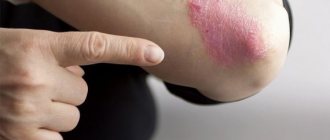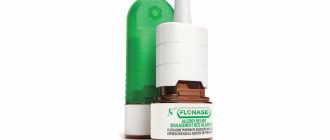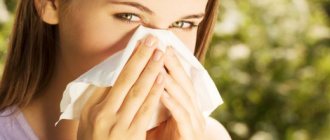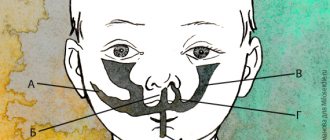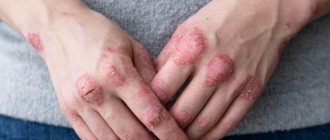The terms "dermatitis" and "eczema" are synonymous. The term eczema is usually applied to the dermatitis seen in atopic individuals. The term "dermatitis" means inflammation of the skin. It can be acute with weeping, formation of crusts and vesicles, subacute or chronic with dryness, peeling and cracks.
Skin rashes are almost always itchy and are usually complicated by secondary infection.
Dermatitis can be exogenous (eg, contact, irritant, infectious or photodermatitis) or endogenous (eg, atopic, seborrheic, discoid).
Most often, the diagnosis is made on the basis of a detailed history and morphological studies of skin rashes, taking into account the characteristics of their distribution.
Atopic dermatitis
Atopic dermatitis begins in childhood, between 2 and 6 months of age, and affects about 2% of the population, but is now experiencing an increase in prevalence. A family history of atopy is present in 70% of patients. Hay fever (hay fever) and/or asthma may develop as your child gets older. More than 90% of children recover by age 12, but it is very difficult to predict this in an individual child.
Atopic dermatitis in children affects the face, neck, and torso. Later, the flexor surfaces are involved in the process: popliteal, elbow, wrist and ankle joints, and as a result of repeated scratching, lichenification of the skin can occur. Hand dermatitis usually appears later in life. Secondary infection is common and often leads to worsening of the dermatitis. Pruritus can be debilitating and cause great distress for patients and families. Some patients, especially infants and young children, have food allergies, most often to eggs, fish and dairy products. With atopic dermatitis, many skin disorders can be identified. Immunological abnormalities include a tendency to increase immunoglobulin E, a predisposition to anaphylactic reactions, and a decrease in local cell-mediated immunity. This leads to increased sensitivity to viral infections.
Make an appointment now!
Leave your contact details or call and our manager will contact you to make an instant appointment
Dermatitis: which cream to choose?
This problem causes discomfort and, in some cases, fear and confusion. Symptoms of dermatitis can affect not only your health, but also your work and personal life. It causes particular concern among young parents, like any illness in the baby.
Dermatitis is usually called any kind of manifestation on the skin that differs from its normal state: redness, peeling, itching, and so on.
If any changes occur, consult a specialist. It is worth noting that 10% of all visits to a dermatologist are related to manifestations of dermatitis. Women apply more often due to greater contact with household chemicals.
Types of Dermatitis
There are two main groups of dermatitis: contact and allergic.
The manifestations of contact dermatitis are:
Acute - the onset is rapid after a single interaction with substances that have a pronounced irritant effect.
Chronic - develops gradually with constant contact with an irritant over several days or even years. In this case, the cause will be mild irritants such as: household chemicals, soap solutions, dry air, dust.
Allergic dermatitis is a manifestation of a malfunction of the body's immune system to one or more irritants, manifested by inflammation.
The most common places of manifestations:
- Skin of hands
- Face
- Neck
- Armpits
- Scalp
- Anogenital area, most often in children.
- Ears
- Shin
- Feet
The manifestations of acute contact and allergic dermatitis are very similar: redness, swelling and rashes in the form of bubbles and blisters and “pimples”. Itching, burning, and soreness of the skin will also be felt. With allergic dermatitis, the manifestations will not be limited to the place of skin contact with the irritant; the reaction goes far beyond its limits. As a result, mandatory consultation with a specialist is necessary to confirm the correct diagnosis and treatment.
In chronic dermatitis, the lesions do not look as bright as in acute dermatitis, but also have swelling, which can be accompanied by: cracks, hyperpigmentation and damage to the integrity of the skin, the desire to scratch and pinch it. Even after eliminating the impact of the irritant, the process can continue for up to several months.
To make an accurate diagnosis, the doctor will need to tell you in detail how, when and after what the skin lesion occurred. Skin tests will also be performed.
Dermatitis is usually called any kind of manifestation on the skin that differs from its normal state.
Treatment
The main goal of treatment is to return the person to the previous comfort and condition of the skin. The priority in the treatment of contact dermatitis is to identify the irritating factor and eliminate it. If it is impossible to eliminate contact, for example, due to professional necessity, adequate and reliable skin protection must be selected (overall clothing, gloves, protective creams and ointments). For simple contact dermatitis, the effectiveness of hormonal ointments and creams is not enough. The effectiveness of the use of selective alcineurin inhibitors tacrolimus and pimecrolimus for the types of dermatitis indicated in the article has not been proven in controlled studies.
In case of severe itching, it is possible to use antihistamines - Zodak, Claritin, Xestin, Erius, Suprastinex, Dizal, Alegra, Xyzal, Fenistil.
Local treatment:
- Cutivate (fluticasone propionate) cream, ointment for 2 weeks
- Triacort, Fluorocort (triamcinolone acetonide) ointment 0.025%, 0.1% for 2 weeks, treatment must begin with a higher dose
- Dermovate, Clobetasol, Psoriderm, Dilasen, Powercourt (clobetasol propionate) ointment for 3–4 weeks
- Akriderm, Beloderm, Celestoderm (betamethasone valerate) cream, ointment 2 weeks
- Uniderm, Elokom, (mometasone furoate) cream, ointment 0.1% 2 weeks
It happens that a bacterial infection can join the course of the underlying dermatitis. In this case, it is worth connecting additional local antibacterial therapy:
- Fucidin (fusidic acid) cream, gel 2% for 1–2 weeks
- Supirocin, Bactroban (mupirocin) ointment 2% for 2 weeks
If there is no result in the treatment of allergic dermatitis, it is possible to use immunosuppressive drugs cyclosporine, azathioprine. Application of UV-B or PUVA therapy.
Prevention of dermatitis is the understanding that this reaction is lifelong and even short-term contact should be avoided.
Reminder for hand skin care for occupational contact dermatitis:
- Be sure to wear gloves
- Use soap substitutes. Soap removes the protective fatty layer of the skin and damages the stratum corneum of the skin, which retains water, thereby greatly increasing permeability to any substances. In addition, some soap components themselves are irritating.
- Avoid Potentially Irritating Substances
- Follow your doctor's recommendations for at least six months
- Do not wear rings as they are a place where irritants accumulate, and if a person is still not ready to give up wearing them, then it is necessary to remove them while working and doing household chores.
- Also regularly use emollients - these are substances similar in composition to the natural protective fatty film of the skin, affecting the upper layers of the skin. They are: natural, chemical, synthetic.
Available daily care products that can be purchased at any pharmacy: Bepanten, Tipikrem, Emolium, Mustela, Lipobase, La-cree.
For adults only: Lokoid, Dermovate, Sinalar. They should only be applied to clean, dry skin.
One of the new directions is the use of corneoprotectors. These are products that restore the integrity of the stratum corneum directly. Physiogel, Oilatum, Lipikar, Protopic.
By self-medicating, you can cause irreparable harm to your health; be sure to consult a doctor and follow his recommendations.
Literature: Federal clinical guidelines for the management of patients with contact dermatitis, Moscow - 2015
Discoid dermatitis
Discoid dermatitis is characterized by the appearance of round or oval spots in symmetrical areas, often on the extensor surfaces, usually in adult patients. Exogenous causes must be excluded.
Dyshidrosis is a variant of eczema in which recurrent vesicles or bullae affect the palms, fingers, toes, or both. The disease is characterized by remissions and exacerbations, which are sometimes provoked by fever, emotional stress, and active fungal infection.
Causes of the disease
The reasons for the development of the disease are not completely clear. Seborrheic dermatitis is not a disease of the sebaceous glands, although it develops in areas saturated with them.
A significant role in the development of the disease is played by yeast-like fungi of the genus Malassezia (they exist on the skin of most healthy people, but in some they can cause rashes and skin irritation), the composition of lipids on the surface of the skin, as well as the characteristics of the immune response to Malazessia fungi and their metabolic products.
In adults, severe disease is associated with the following conditions:
- oily skin (seborrhea);
- lack of sleep and stress;
- history of seborrheic dermatitis and psoriasis in relatives;
- states of immunosuppression (organ transplantation, HIV, lymphoma);
- neurological or psychiatric disease.
The main cause of seborrheic dermatitis in children is increased activity of the sebaceous glands (rapid growth and secretion of sebum), which occurs due to the circulation of maternal hormones in the child’s blood in the first weeks of life. Malacesia is not a leading factor in children, unlike in adults.
Irritative dermatitis
In irritative dermatitis, the rash may be caused by physical or chemical irritation and damage to the skin, in which case it is not usually associated with an allergy. This type of damage can be caused by soap, detergents, food products, and building materials.
The necessary examination and adequate modern treatment for each form of dermatitis can be determined by highly qualified specialists of our center - the Three I Immunology Clinic - allergists and dermatologist. Come visit us at Novosibirsk, st. Galushchaka, 2, we will help solve your problems!
Diagnostics
When diagnosing seborrheic dermatitis, it is necessary to exclude skin diseases such as atopic dermatitis, eczematitis, psoriasis, fungal diseases (ringworm) and microbial skin lesions. To do this, it is necessary to conduct a microscopic and mycological examination of skin flakes for pathogenic fungi . Sometimes they resort to a diagnostic biopsy, in which, in combination with numerous signs, neutrophil cells will be recorded in the crusts and scales, as well as in the mouths of the hair follicles. For seborrheic dermatitis that occurs torpidly, additional research into the patient’s hormonal status is necessary.
Facial dermatitis: symptoms and signs
If you have the following symptoms, you can confidently say that you have dermatitis on your face:
- Redness, dryness and flaking of the skin;
- Acne-like rashes;
- Pimples with dermatitis on the face are often located in groups;
- The rashes look like mounds filled with clear contents or purulent fluid;
- The area where rashes with skin dermatitis on the face are most often located is the chin and areas around the mouth;
- With dermatitis, swelling of the face is often observed.
Prevention
Treatment with ointment for perioral dermatitis is not always a panacea. In some cases, the disease can return, so the course of taking medications can be long. Any irritant often leads to the appearance of the disease. Following simple recommendations will help you avoid possible risks:
- Check the composition of cosmetic products and treat their choice with special attention
- Don't neglect personal hygiene
- Strengthen your immunity
- Eat right and monitor your digestive health
- Be aware of allergies
- Monitor hormonal balance during pregnancy, in case of possible changes due to nervousness, illness or other reasons
Perioral dermatitis detected at the first stage is the easiest and fastest to treat, so remain sensitive to the body’s signals and begin the fight against the first symptoms of the disease in a timely manner.
Perioral dermatitis: causes
Experts have not fully identified the causes of perioral dermatitis. However, it is generally accepted that this is a complex, multifactorial disease that has a wave nature (with stages of exacerbation and remission, respectively).
It is usually customary to associate the appearance of a rash around the mouth with hormonal changes that occur:
- when taking various medications, primarily when using ointments based on corticosteroids. Most often, corticosteroids are prescribed as one of the main means for the treatment of acne, rosacea, blackheads, eczema, etc. It is in the case of using corticosteroid ointment that perioral dermatitis can be detected in teenage boys;
- during pregnancy: this type of dermatitis is often diagnosed in women during pregnancy, which makes it possible to assume a hormonal origin of the disease, since pregnancy most often entails serious hormonal changes in the female body. For the same reasons, dermatitis most often worsens before the start of the menstrual cycle. Hormonal changes often occur in newborns, which fully explains the possibility of dermatitis in young children.
Among other things, such dermatitis can occur due to:
- abuse of cosmetics: most often we are talking about both decorative cosmetics (foundation and powder in the first place), and moisturizing creams, scrubs, tonics;
- using fluoride-containing pastes that can irritate the skin around the mouth;
- severe chapping of the skin, especially in the cold, as well as severe insolation (absorption of large amounts of sunlight);
- infections: often during the diagnostic process various infectious agents are discovered (streptococcus, staphylococcus, etc.), but specialists have not yet been able to identify a single agent that can cause the development of this type of dermatitis;
- failure of the immune system, which most often occurs due to a lack of vitamins in the body, especially in adolescents, who during the period of active growth experience a special need for vitamins. In this regard, it is also customary to include an imbalance of intestinal microflora, which occurs due to problems with the digestive organs, as provoking factors for dermatitis.
Perioral dermatitis: consequences
Dermatitis of this type is a very unpleasant dermatological problem, which, in the absence of timely professional intervention, can spread further over the skin of the face. In addition, usually the papules are destroyed, and in their place crusts form, the premature removal of which can cause hyperpigmentation (more intense coloring) of certain areas of the skin.
In case of large skin lesions, especially against the background of weakened immunity, including in children, purulent, weeping ulcers can form in place of papules (pimples), causing patients a lot of discomfort.
In addition, sometimes, in relatively rare cases, oral dermatitis can affect not only the area around the mouth, but also be found on the skin around the eyes, on the lower and upper eyelids. At the same time, dermatitis poses a potential danger to the patient’s vision (primarily if diagnosed in small children), and therefore requires timely consultation with an ophthalmologist
.

